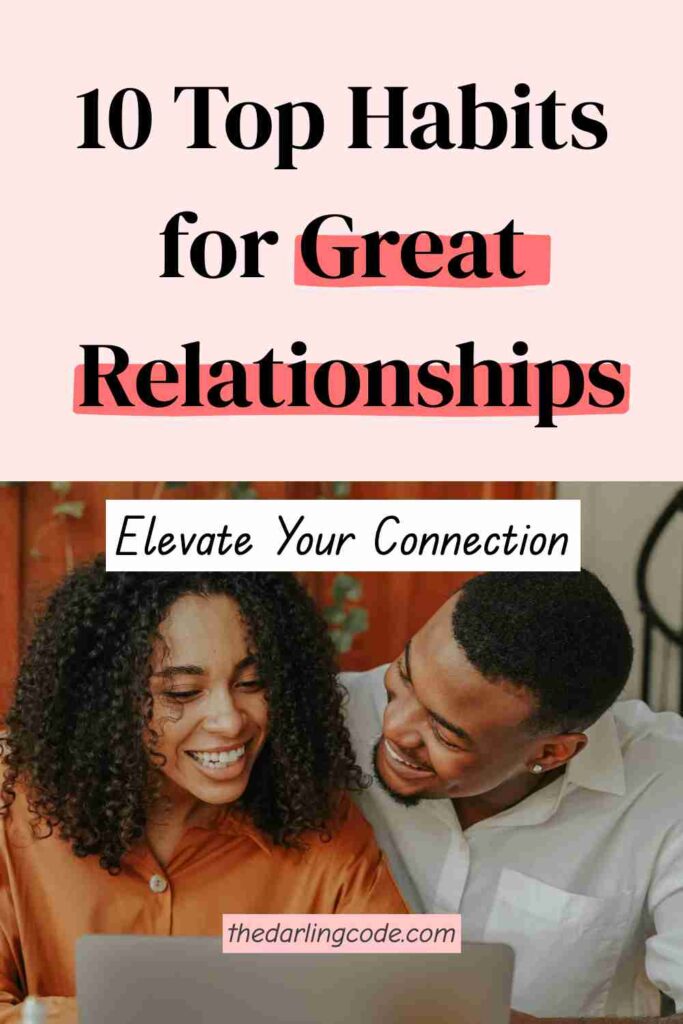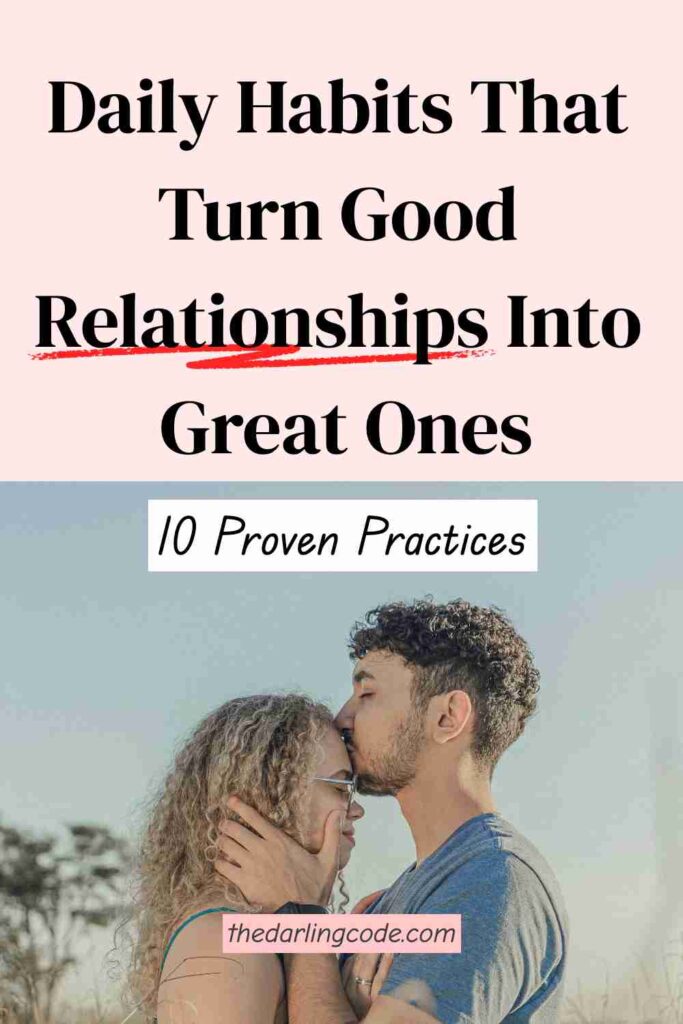10 Daily Habits That Turn Good Relationships Into Great Ones
The experiences shared in this article are based on real emotional journeys, but all personal details are anonymized and used with the explicit written permission of the clients. Any resemblance to actual persons, living or dead, is purely coincidental. We are committed to treating all client stories with the utmost confidentiality and respect.
You know that cozy feeling when you’re sipping coffee on a rainy Sunday morning, wrapped in a blanket with someone who just gets you?
That’s the magic of a good relationship.
But here’s the secret: Great relationships aren’t built on grand gestures or fairy-tale moments.
They’re crafted through small, intentional habits that add up over time—like pennies in a piggy bank.
As a relationship coach who’s spent years guiding clients through everything from first-date jitters to decade-long partnerships (and navigating my own dating life in between), I’ve seen firsthand how tiny shifts can create seismic waves of connection.
Today, let’s talk about the daily rituals that transform “good enough” into “I can’t believe how lucky I am.”
Save this article for later—Pin it to Pinterest and come back when you need it! 📌

1. The 3-Second Hug (No, Really)
Science tells us that hugs lasting longer than three seconds release oxytocin—the “bonding hormone.”
But beyond biology, this habit forces you to pause and be present.
One client, Sarah, shared how her habit of hugging her partner before leaving for work (even during arguments) became their emotional reset button. “It’s hard to stay mad when you’re literally holding each other,” she laughed.
Try this:
- Set a timer if you need to (no shame!)
- Let your body relax into the embrace—no stiff “pat-pat” exits
- Bonus: Add a deep inhale together to sync your breathing
2. Ask “What’s Alive for You?”
Instead of defaulting to “How was your day?” (which often gets a robotic “fine”), borrow this question from somatic therapy practices. It invites vulnerability without pressure.
Last winter, my boyfriend used this after I’d had a draining work call.
Instead of my usual “I’m okay,” I burst into tears and admitted I felt overwhelmed.
That conversation became a turning point in how we support each other’s careers.
Pro tip: Pair it with a specific observation:
“You seemed quiet during dinner. What’s alive for you right now?”
When tensions are high:
“I notice you’re tapping your foot. What’s feeling urgent?”
3. Text the Tiny Things
A client once told me, “My ex never texted unless it was logistics.
My current partner sends me photos of weird parking signs.” Those mundane updates—a funny dog, a sunset, a meme—are emotional breadcrumbs saying, “You’re on my mind.”
But: Avoid turning this into a chore. If you’re not a natural texter:
- Set one daily “thinking of you” alarm
- Use voice memos if typing feels tedious
- Try Marco Polo for video snippets
Caution: If they don’t reciprocate, have a gentle check-in:
“I’ve been sending those silly coffee cup photos—does that feel connecting to you?”
4. Create a “No Phone Zone”
I’ll never forget a couple’s therapy session where both partners realized they’d been scrolling Instagram during their nightly “quality time.”
Designate 20 minutes daily (during meals, walks, or bedtime) where devices stay out of reach.
One couple I worked with started keeping their phones in a vintage cookie jar—a playful reminder to focus on each other.
For long-distance relationships:
- Use FaceTime “co-working” dates with muted mics
- Try the Freeletics app for synchronized workouts
- Mail handwritten “open when” letters
5. Practice “Repair, Don’t Compare”
Arguments happen. What separates great relationships? The ability to repair before resentment sets in. After a disagreement:
The 10-Minute Rule:
“Let’s pause and revisit this in 10 minutes.”
(Use that time to breathe, not rehearse your comeback)
The Apology Sandwich:
- “I’m sorry I snapped.”
- “I was stressed about [specific thing].”
- “Let’s try again.”
For recurring fights: Create a code word. One couple uses “pineapple” when they sense an old argument pattern emerging.
6. Celebrate Micro-Wins
Did your partner finally fix that squeaky cabinet?
Did they listen patiently while you vented about your boss?
Acknowledge it!
A client’s husband once told her, “You thanking me for unloading the dishwasher made me want to do it more often.”
What to try:
- Leave sticky notes on bathroom mirrors
- Text “I noticed…” statements
- Do a weekly “appreciation inventory”
Caution: Avoid overpraising basic decency (“Thanks for not ghosting me!”). Focus on efforts that align with your shared values.
7. Schedule “Alone-Together” Time
You don’t have to be joined at the hip.
My favorite weekends involve me reading in bed while my partner builds LEGO sets nearby.
This “parallel play” nurtures intimacy without pressure to perform.
Ideas:
- Cook separate meals side by side
- Take a “no talking” nature walk
- Read aloud from different books
Pro tip: For new parents, try “shift parenting” where one handles baby duty while the other simply exists nearby guilt-free.
8. Learn Their Love Language… and Yours
Yes, it’s a cliché for a reason.
But here’s the twist: Most people need multiple languages.
One newlywed realized her husband felt loved through acts of service (hello, coffee in bed) but craved words of affirmation during stressful work weeks.
Deep dive questions:
- “What made you feel cherished as a child?”
- “How do you want to be comforted when sick vs. stressed?”
- “What’s your ‘anti-love language’? (Pet peeves that feel dismissive)
9. The “5:1 Ratio” Secret
Research shows healthy relationships have five positive interactions for every negative one.
But “positive” doesn’t mean elaborate—it could be:
- A shared laugh over burnt toast
- A shoulder squeeze during a tense movie scene
- Texting “I appreciate you” during their big meeting
Watch out: If you’re tallying points (“That’s only ratio 3:1 today!”), you’re missing the point. Let this ratio guide, not govern.
10. End the Day With a “Gratitude Whisper”
Before sleep, share one specific thing you appreciated about each other that day. It could be:
- “Thanks for making the bed”
- “I loved how you handled that awkward family text”
- “Your laugh during the comedy special was contagious”
A client in a long-distance relationship does this via voice notes: “Hearing his voice say ‘I’m proud of you’ feels like a lullaby.”
For tough days: “I’m grateful we got through today together.”
Final Words from The Darling Code
Great relationships aren’t about perfection—they’re about showing up, day after day, with curiosity and kindness.
Start small: Pick one habit that resonates with you this week.
Maybe it’s:
- The three-second hug after work
- Sending a “weird parking sign” photo tomorrow
- Whispering “I noticed…” before bed
Progress, not pressure. And if you slip up? That’s normal. What matters is choosing to reconnect—even (especially) when it’s messy.
You deserve a love that feels like coming home.
With heart,
The Darling Code
P.S. Save this article to your Pinterest “Relationship Goals” board. Today’s challenge: Send someone you love a “tiny thing” text. A taco emoji counts. 🌮
Got value from this article? Pin it to Pinterest for easy reference and help others discover it! 🌟


ABOUT THE AUTHOR
Vivienne, Relationship Coach & Self Love Coach
Vivienne is a Relationship Coach and Self-Love Coach who believes the key to great relationships starts with YOU. She helps individuals and couples build confidence, set healthy boundaries, and create connections that truly honor who they are.






